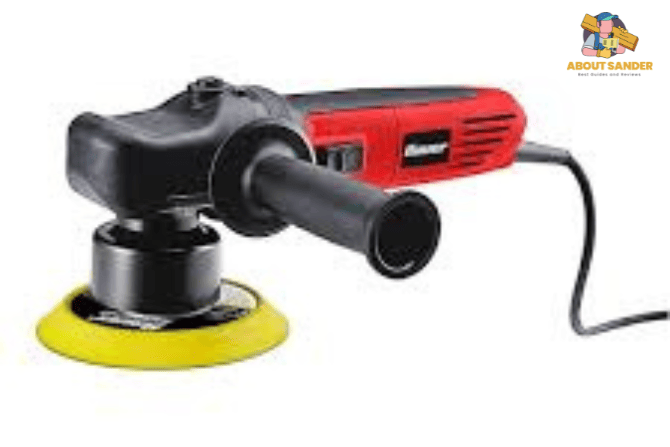As an expert in power tools and surface finishing, one common question is, “Can I use a DA sander for polishing?” This article will delve into the world of Dual Action (DA) sanders and their suitability for polishing tasks. We will explore the advantages, limitations, and best practices to achieve the desired results to know can i use a DA sander for polishing applications.
Key Takeaways:

- Understanding the purpose of a DA sander and its differences from other sanders.
- Exploring the potential applications of a DA sander in polishing.
- Identifying the limitations and challenges about can i use a DA sander for polishing tasks.
- Essential tips and techniques to optimize the polishing process with a DA sander.
Can I Use a DA Sander for Polishing? A Step-by-Step Guide
Dual Action (DA) orbital sanders can be employed for polishing tasks when used correctly.
While they may not provide the precision and control of dedicated polishers, DA sanders can still deliver satisfactory results in certain applications. In this step-by-step guide, we will walk you through how to use a DA sander for polishing effectively.
1: Choose the Right Polishing Pads and Compounds
Selecting the appropriate polishing pads and compounds is crucial for achieving the desired results with a DA sander. Soft foam or microfiber pads are commonly used for polishing, as they provide the necessary cushioning and even distribution of the polishing compound. Also, choose polishing compounds suitable for the material you are working on, such as paint, metal, or plastic.
2: Prepare the Surface
Before beginning the polishing process, ensure the surface is clean and free from debris or contaminants. Use a separate cleaning step, if necessary, to remove any dirt or grime that could interfere with the polishing process. A clean surface will allow the polishing pad to work more effectively, producing better results.
3: Apply the Polishing Compound
Dab a small amount of the selected polishing compound onto the polishing pad. Be cautious to use only a little compound, as the excessive application can lead to messy and inefficient polishing. Spread the compound evenly across the surface to be polished.
4: Set Up the DA Sander
Attach the chosen polishing pad securely to the DA sander’s backing plate. Ensure the pad is centered and aligned correctly to avoid wobbling or uneven polishing. Depending on the model of your DA sander, it may have a single or dual-action mode. For polishing, use the dual-action mode, which combines orbital and rotary movements.
5: Begin Polishing
Place the DA sander onto the surface to be polished, applying gentle pressure. Move the sander in slow, overlapping passes to ensure even coverage and avoid creating swirl marks or uneven areas. Allow the sander to do the work, and avoid pressing down too hard, as excessive pressure may cause heat buildup and potential damage to the surface.
6: Work in Small Sections
Polish the surface in small sections at a time. Working in smaller areas allows for better control and ensures the polishing compound remains effective. It also prevents the compound from drying out before properly working on the surface.
7: Check Your Progress
Periodically stop and inspect your progress to determine if the desired level of shine has been achieved. Repeat the polishing process on the same area until the desired results are obtained. Always check for swirl marks, scratches, or areas requiring further attention.
8: Finishing Touches
Once you have polished the entire surface, examine it thoroughly for any missed spots or imperfections. You can apply hand polishing to specific areas to achieve a more refined and high-gloss finish.
Limitations of Using a DA Sander for Polishing

While a Dual Action (DA) sander offers versatility and effectiveness in sanding tasks, it has inherent limitations when used for polishing applications. In this section, we will explore the key limitations of using a DA sander for polishing and understand how these factors can impact the quality and efficiency of the polishing process.
1: Lack of Precision Due to the DA Sander’s Elliptical Motion
The primary motion of a DA sander involves a combination of rotary and orbital movements, resulting in an elliptical pattern. This motion can lead to poor precision during polishing, especially on curved or contoured surfaces. The uneven pressure distribution may result in inconsistent polishing results, making achieving a uniform and flawless finish challenging, particularly in intricate or detailed areas.
2: Limited Speed Control Compared to Dedicated Polishers
Unlike dedicated polishers, which often offer variable speed settings, most DA sanders have limited speed control options. The need for adjustable speed settings can be a hindrance during polishing tasks, where different materials or surface conditions may require varying speeds for optimal results.
3: Lower RPM (Revolutions Per Minute) Affecting High-Gloss Finishes
The RPM of a DA sander is generally lower than that of specialized polishers. This lower RPM can be a limiting factor when trying to achieve high-gloss finishes, as it may take more time and effort to reach the desired level of shine. In some cases, a DA sander might not produce the gloss and reflective clarity that dedicated high-speed polishers can achieve.
4: Limited Range of Polishing
Pad Options, Reducing Versatility Compared to dedicated polishers, DA sanders often have a narrower range of polishing pads. The limited options can impact the tool’s versatility, making it less suitable for certain polishing tasks requiring specific pad materials, sizes, or densities.
Potential Applications of a DA Sander in Polishing

A Dual Action (DA) sander is a versatile power tool commonly used for sanding tasks due to its unique rotary and orbital motion combination. While its primary function is sanding, it can also be used for certain polishing applications. In this section, we will explore the potential applications of a DA sander in polishing and how it can be utilized to achieve satisfactory results in specific scenarios.
1: Polishing Rough Surfaces
Using a DA Sander Polishing rough surfaces is one of the potential applications of a DA sander, provided the right polishing pads and compounds are used. The oscillating and rotating motions of the DA sander help distribute the polishing compound evenly, resulting in a more uniform finish.
2: Preparing Surfaces for Polishing with a DA Sander
Before proceeding with a dedicated polishing tool, using a DA sander to prepare the surface can be beneficial, especially when dealing with deeper scratches or imperfections. The DA sander’s sanding action helps remove the bulk of the material, making it easier for the polishing tool to achieve a high-gloss finish later.
Frequently Asked Questions About Using a DA Sander for Polishing
As the popularity of Dual Action (DA) sanders continues to grow, more individuals are curious about their suitability for polishing tasks. Let’s explore these FAQs to help you understand the possibilities and limitations of using a DA sander in polishing tasks.
1: Can I achieve a high-gloss finish using a DA sander?
Achieving a high-gloss finish with a DA sander alone can be challenging. DA sanders are more suited for sanding tasks and may not offer the precision and speed required to achieve a mirror-like, high-gloss surface.
2: Is a DA sander suitable for polishing car paint?
A DA sander can be used for polishing tasks on car paint, but it may not deliver the flawless results a dedicated polisher can achieve. For achieving a show-quality, high-gloss finish on car paint, consider using a dual-action polisher with variable speed control to minimize the risk of heat buildup and maintain better control over the polishing process.
3: What type of pads should I use with a DA sander for polishing?
Opt for soft foam or microfiber pads when using a DA sander for polishing. These pads are designed to work with the oscillating and rotating motion of the DA sander, ensuring even distribution of the polishing compound and minimizing the risk of creating swirl marks.
Conclusion:
In conclusion, while a DA sander can be utilized for some light polishing applications, there are more suitable tools for achieving high-gloss finishes. Its limitations in speed control, precision, and available pad options may impact the quality of the final result. Consider using dedicated polishing tools that offer better power and versatility for professional-grade polishing results.

Why Trust About Sanders?
When it comes to the world of sanding and sanders, you need a trusted source of information and guidance to ensure you achieve those perfect finishes. That's where I come in – I'm Martin, a dedicated sanding enthusiast with a relentless passion for attaining flawless surfaces. With years of hands-on experience in the sanding industry, I've honed my skills and expertise to provide you with the most reliable and accurate insights. What sets me apart is my commitment to excellence. I meticulously handpick each sander after rigorous testing, ensuring that only the best tools make it to your hands. My goal is to empower you with the knowledge and recommendations you need to tackle any sanding task confidently. When you trust About Sanders, you're putting your faith in a seasoned expert who shares your passion for perfection and strives to deliver top-notch information and reviews for every sanding challenge.
